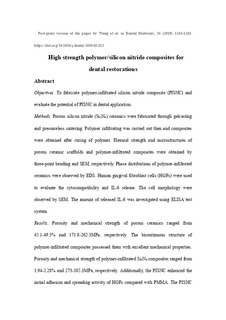| dc.contributor.author | Wang, Feng | |
| dc.contributor.author | Guo, Jingshu | |
| dc.contributor.author | Li, Ke | |
| dc.contributor.author | Sun, Jian | |
| dc.contributor.author | Zeng, Yuping | |
| dc.contributor.author | Ning, Congqin | |
| dc.date.accessioned | 2019-11-06T08:22:12Z | |
| dc.date.available | 2019-11-06T08:22:12Z | |
| dc.date.created | 2019-07-11T08:51:03Z | |
| dc.date.issued | 2019 | |
| dc.identifier.issn | 0109-5641 | |
| dc.identifier.uri | http://hdl.handle.net/11250/2626784 | |
| dc.description.abstract | Objectives
To fabricate polymer-infiltrated silicon nitride composite (PISNC) and evaluate the potential of PISNC in dental application.
Methods
Porous silicon nitride (Si3N4) ceramics were fabricated through gelcasting and pressureless sintering. Polymer infiltrating was carried out then and composites were obtained after curing of polymer. Flexural strength and microstructures of porous ceramic scaffolds and polymer-infiltrated composites were obtained by three-point bending and SEM, respectively. Phase distributions of polymer-infiltrated ceramics were observed by EDS. Human gingival fibroblast cells (HGFs) were used to evaluate the cytocompatibility and IL-6 release. The cell morphology were observed by SEM. The amount of released IL-6 was investigated using ELISA test system.
Results
Porosity and mechanical strength of porous ceramics ranged from 45.1 to 49.3% and 171.8–262.3 MPa, respectively. The bicontinuous structure of polymer-infiltrated composites possessed them with excellent mechanical properties. Porosity and mechanical strength of polymer-infiltrated Si3N4 composites ranged from 1.94 to 2.28% and 273–385.3 MPa, respectively. Additionally, the PISNC enhanced the initial adhesion and spreading activity of HGFs compared with PMMA. The PISNC showed similar IL-6 release performance with PMMA samples. | nb_NO |
| dc.language.iso | eng | nb_NO |
| dc.publisher | Elsevier | nb_NO |
| dc.rights | Attribution-NonCommercial-NoDerivatives 4.0 Internasjonal | * |
| dc.rights.uri | http://creativecommons.org/licenses/by-nc-nd/4.0/deed.no | * |
| dc.title | High strength polymer/silicon nitride composites for dental restorations | nb_NO |
| dc.type | Journal article | nb_NO |
| dc.type | Peer reviewed | nb_NO |
| dc.description.version | acceptedVersion | nb_NO |
| dc.source.journal | Dental Materials | nb_NO |
| dc.identifier.doi | https://doi.org/10.1016/j.dental.2019.05.022 | |
| dc.identifier.cristin | 1711173 | |
| dc.description.localcode | © 2019. This is the authors’ accepted and refereed manuscript to the article. Locked until 12.6.2021 due to copyright restrictions. This manuscript version is made available under the CC-BY-NC-ND 4.0 license http://creativecommons.org/licenses/by-nc-nd/4.0/ | nb_NO |
| cristin.unitcode | 194,64,45,0 | |
| cristin.unitname | Institutt for konstruksjonsteknikk | |
| cristin.ispublished | false | |
| cristin.fulltext | postprint | |
| cristin.qualitycode | 1 | |

